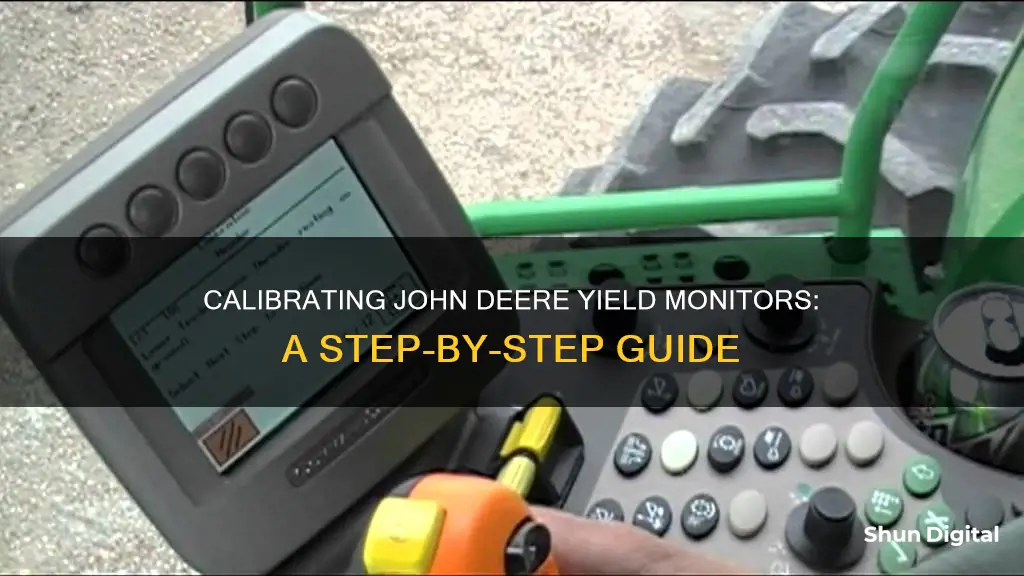
Calibrating a yield monitor is an important step in ensuring that you are using high-quality yield data to make decisions in your operations. While the process may vary depending on the make and model of your yield monitor, a typical calibration process involves three steps: harvesting a calibration load, weighing the load to get a ground truth weight, and entering this weight into the yield monitor display. For John Deere yield monitors specifically, there are additional considerations and resources available, as discussed in online forums and user guides. Proper calibration ensures accurate yield calculations and can help identify any issues with the yield monitor's performance.
| Characteristics | Values |
|---|---|
| Calibration Process | Single or multipoint calibration |
| Calibration Steps | Harvest a calibration load, weigh the load, enter the ground truth weight into the yield monitor display |
| Scale System | Required to get a "ground truth" load weight |
| Scale System Examples | Seed buggies with scales, grain carts with scales, truckload scale tickets from an elevator |
| Grain Cart Scale Tip | Verify grain cart scales against truck load net weights from elevator scale tickets |
| Calibration Process for Different Flow Rate Ranges | Required to ensure the yield monitor is accurately calculating yield |
| Calibration Process for Different Flow Rates | Collect several calibration loads at normal operating speed, then capture calibration loads at slower and faster ground speeds |
| Recalibration | Required when crop moisture changes |
| Recalibration Interval for Corn | Every 2.5% change in moisture to maintain yield monitor error of less than 5% |
| Mechanical Components | Sensor, clean grain elevator chain |
What You'll Learn

Calibration load weight
To calibrate the yield monitor of a John Deere harvester, you need to calculate the calibration factor. This is done by comparing the displayed weight and actual weight of a calibration load.
The formula for calculating the new yield calibration number is: Displayed Weight/Actual Weight x Current Yield Cal # = New Yield Cal #.
For example, if the displayed weight of your calibration load is 100kg and the actual weight is 95kg, the calculation would be as follows:
100/95 x Current Yield Cal # = New Yield Cal #.
So, if your current yield calibration number is 10, the new number after calibration would be:
100/95 x 10 = 10.53.
This process ensures that the yield monitor accurately reflects the weight of the harvested crop and allows for adjustments to be made if the displayed weight is inconsistent with the actual weight.
It is important to note that this formula is specific to the John Deere yield monitor, and other yield monitors may or may not use the same formula.
Effective Ways to Remove Libre Glucose Monitors
You may want to see also

Ground truth weight
To calibrate a yield monitor, you will need to establish a "ground truth" load weight. This is done by weighing a calibration load on a grain cart or truck. This weight is then entered into the yield monitor display.
For multi-point calibrations, the load should be between 3,000 and 6,000 lbs, and for single-point calibrations, the load can be larger, up to a full grain tank. No matter the make and model of your yield monitor, a scale system is needed to get this ground truth load weight. This can be done in several ways, including using seed buggies with scales, grain carts with scales, or truckload scale tickets from an elevator.
When collecting ground truth load weights for your yield monitor calibration, it is important to verify that the scale system you are using is accurate. If it is not, you could introduce more errors into your yield data. To ensure the accuracy of your grain cart scales, it is a good practice to verify them against truck load net weights from elevator scale tickets. This will help ensure that your grain cart scales remain accurate throughout the season.
When using your grain cart to calibrate your yield monitor, it is recommended to leave the grain cart half full when collecting ground truth weights. This will ensure that the weight range on the grain cart scales is closer to the full cart weight values that you have been verifying against elevator tickets.
Removing HP Monitor Stand: A Step-by-Step Guide
You may want to see also

Scale accuracy
The mass flow sensor calibration process involves harvesting individual loads of grain and verifying their actual weight using accurate scales. The verified weights are then manually entered into the yield monitor's calibration screen. Built-in software procedures are utilised to calibrate the display's weight estimates, aligning them with the scale's estimates. It is recommended to minimise calibration errors to 5% or less. Modern displays can often be calibrated to achieve even greater accuracy, with errors of only 1% or lower.
The number of calibration loads required depends on the calibration method chosen: near-linear or non-linear calibration. Near-linear calibration necessitates one or two calibration loads to generate a calibration line, whereas non-linear calibration demands at least four loads to establish a calibration curve. Regardless of the method, it is important to ensure that the calibration loads represent different grain flow rates. This is achieved by harvesting each load at varying speeds or with different swath widths.
For optimal results, it is advised to use loads weighing between 3,000 and 8,000 pounds for most yield monitors. However, for the Precision Planting YieldSense™ system, calibration loads of 25,000 pounds or three 10,000-pound loads are recommended to enhance calibration accuracy.
It is worth noting that calibration loads should be harvested under consistent conditions, avoiding areas with significant topography changes, such as turn rows, weed patches, or hilly terrain. If encountering such variations, ensure you collect representative loads from both uphill and downhill directions and across the hill.
In addition to the mass flow sensor calibration, other factors that contribute to scale accuracy include the moisture content of the grain and the ground speed calibration. By paying close attention to these factors and following the manufacturer's recommendations, you can ensure that your yield monitor provides precise and reliable data.
USB Ports on Monitors: A Deal-Breaker?
You may want to see also

Multi-point calibration
The goal of multi-point calibration is to capture the full range of grain flow rates or yield levels that you expect to encounter during the harvest. Each calibration load should be harvested at a different, uniform grain flow rate to mimic the range of rates you will experience when harvesting a field. This can be achieved by harvesting strips at different speeds or varying the widths of the strips (full header, 3/4 header, 1/2 header, etc.).
For multi-point calibration, each load should be between 3,000 to 6,000 lbs (50 to 100 bu grain). The grain weight of each load is estimated by the yield monitor as the grain is harvested. The grain is then offloaded from the combine hopper and weighed on calibrated or "known to be accurate" weigh wagons or commercial scales.
After weighing, the actual weight of each load is entered into the yield monitor console. The yield monitor firmware will then make mathematical adjustments to the calibration response curve. This process involves fitting a response curve between grain flow rate and flow sensor signal strength to estimate low, medium, and high yields.
It is important to note that multi-point calibration can be time-consuming and cumbersome due to the need to harvest at different speeds or widths and the subsequent offloading and weighing of individual grain loads. However, it is crucial to ensure accurate yield estimates, especially if you intend to use the data for yield comparisons or experimental treatments.
Monitoring Team Performance: Effective Project Management Strategies
You may want to see also

Self-calibration
For combines that use mass flow sensors, it is important to calibrate the monitor for each crop, and this may need to be done more than once a year. This can be done by harvesting a calibration load, weighing it, and entering the ground truth weight into the yield monitor display. This process can be repeated for multi-point calibrations using different crop flow rates.
To ensure the most accurate calibration, the combine should be harvesting at the same speed that most of the harvesting will take place at. This will ensure the yield monitor performs at its best in the field.
It is important to calibrate at multiple flow rates to avoid less accurate field totals and spatial distribution of yield on a yield map.
Concealing Ankle Monitors: Strategies for Discretion
You may want to see also
Frequently asked questions
The calibration process will depend on the type of yield monitor you have. Most yield monitoring systems require a single or multipoint calibration. Refer to the manufacturer’s guidelines to ensure you are meeting or exceeding calibration requirements. A typical calibration process involves three steps: harvesting a calibration load, weighing the calibration load, and entering the ground truth weight into the yield monitor display.
It is important to calibrate your yield monitor before heading into the field for harvest to ensure your monitors, sensors, and scales are getting accurate numbers. You can refer to the manufacturer's guidelines to determine how often calibration is needed. Additionally, you may need to recalibrate when crop moisture changes, as changes in grain moisture can affect the accuracy of the calibration.
Calibrating your John Deere yield monitor ensures that you are using high-quality yield data to make informed decisions in your operations. Accurate yield data helps you understand the yield performance of your crops and can inform decisions related to crop management, harvesting, and yield optimization.







